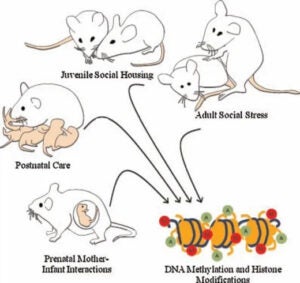
So we have considered resilience in a few different ways, but in considering creating working behavioral pathways we must also consider epigenetics. NOVA produced a great TV program that can work as a primer for epigenetics (https://www.pbs.org/wgbh/nova/genes/).
Epigenetics refers to things that occur outside of the ATCG rungs of the DNA ladder. It is associated with modifications to the histones that impact the arrangement/compaction of the DNA strands. We have learned that changes at the histones act to express or silence some genes. It makes a great deal of sense to have a redundant system that impacts gene expression based on the direct impact of the contemporary environment. We have seen research showing that epigenetics impact stress, learning and memory, social interaction, and fight or flight responses. These changes can occur any time from en utero to late life. Epigenetic change is far more likely than hoping for a positive genetic mutation that does not exist within the germline.
When creating behavioral pathways you can have an impact at a higher level than just training and this impact may have a trans-generational influence over future offspring. Therefore it is crucially important to make sure en utero, maternal affects, and early experience provides pups with positive (for the desired behavioral pathway) gene expression through interaction with the environment. Just make sure that the handler/trainer is most often removed from that interaction for fear of reducing the detection dog’s independent behavior.

